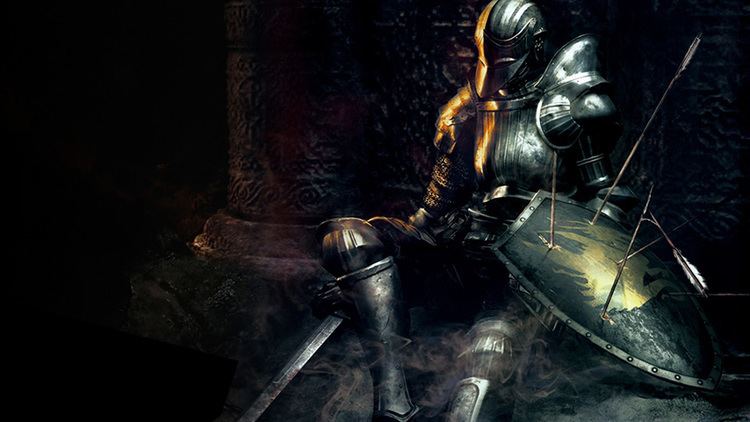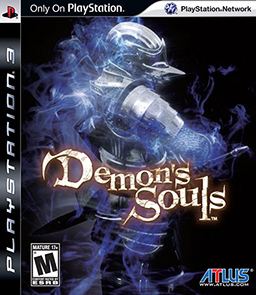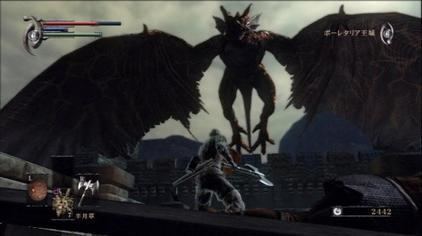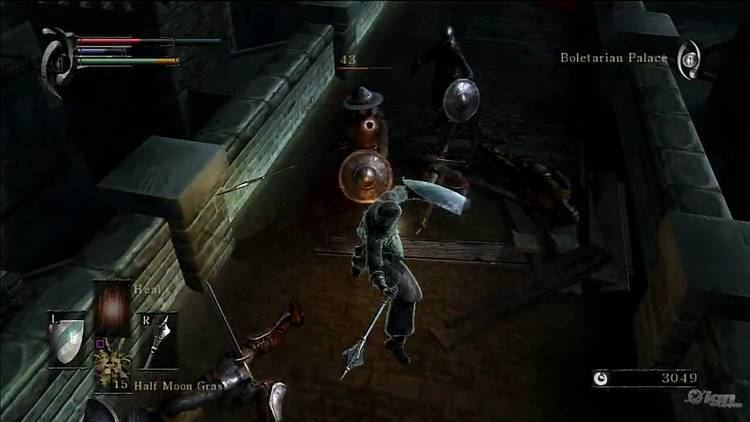9.4 /10 1 Votes9.4
Composer(s) Shunsuke Kida Series Souls | 4.7/5 PlayStation®Store Programmer(s) Jun Ito Initial release date 5 February 2009 | |||||||||||||||||||||||||||||||||
 | ||||||||||||||||||||||||||||||||||
Producer(s) Masanori TakeuchiTakeshi Kajii Artist(s) Makoto SatohMasato MiyazakiHisao Yamada Release date(s) JP: February 5, 2009NA: October 6, 2009AU: June 23, 2010EU: June 25, 2010 Designer Sony Interactive Entertainment Similar Souls games, FromSoftware games, Action-adventure games | ||||||||||||||||||||||||||||||||||
Demon s souls review
Demon's Souls (デモンズソウル, Demonzu Souru) is an action role-playing video game developed by FromSoftware, with direction by Hidetaka Miyazaki, under supervision by SCE Japan Studio, for the PlayStation 3. It was published in Japan by Sony Computer Entertainment in February 2009, in North America by Atlus USA in October 2009, and in Australia and Europe by Namco Bandai Games in June 2010. It is the first installment in the Souls series of games.
Contents
- Demon s souls review
- Demon s souls video review by gamespot
- Gameplay
- Online
- Plot
- Development
- Release
- Merchandise and other media
- Reception
- Sales
- Awards
- References

Set in a dark fantasy world, players take control of a hero who has journeyed to the fictional kingdom of Boletaria, which is being ravaged by a cursed fog that brings forth demons who feast on the souls of mortals. The game was described as a spiritual successor to the King's Field series of games, while at the same time being described as a separate entity from it. The gameplay involves a character-creation system and emphasizes gathering loot through combat with enemies in a non-linear series of varied locations, with a heavy emphasis on challenging combat. It has a unique online multiplayer system integrated into the single-player where players can leave useful messages and warnings for other players' single-player game worlds, as well as joining other players in their world to assist and/or kill them.

Upon its release, Demon's Souls was met with acclaim from critics, winning numerous awards. The game was praised for its dark fantasy art design, variation in combat choice and integrated online interactions. The game is particularly notable for its high difficulty level, with many critics noting it as a genuine challenge. The game Dark Souls, which itself spawned two sequels, is a spiritual successor to Demon's Souls, and was also one of the primary inspirations for Bloodborne.

Demon s souls video review by gamespot
Gameplay
Players take control of the main character who, at the start of the game, can be customized by choice of gender, appearance, name and starting class. There are 10 starting classes, ranging from knights and barbarians to thieves and mages. Each class has its own starting statistics, gear, weapons and type of magic used which all emphasize certain approaches to combat depending on the player's preference.
As players kill demons, they gain souls which act as currency that can be used to buy, repair, and upgrade weapons as well as increase player statistics such as strength, luck, and endurance. Along with souls, players can retrieve items such as weaponry and ore for upgrading. When a player is killed during a level, they are sent to the beginning of the level with all non-boss enemies re-spawned, and the player returns in soul form with lower maximum health and the loss of all unused souls. If the player manages to reach their bloodstain at the point where they were last killed, they regain their lost souls. However, if they are killed before then, the souls are lost permanently. Upon defeating a boss, the player can choose to re-spawn back to that location, marked in the form of an Archstone. When not exploring a level, players reside in the Nexus, a realm of souls that acts as a hub where players can exchange souls, store items and travel between regions. After completing the initial portion of the first region, players can choose to progress through any other of the newly available regions.
Gameplay can change depending on both the World and Character tendency, which can be either white or black. Tendency depends on the actions of the player such as helping or killing NPCs. When white, enemies are easier, yet the soul and items rewards are fewer; when black, enemies are stronger and give greater rewards. Players can manipulate their tendency to suit their current needs. Character tendency affects the player throughout, while World Tendency only affects the region where an action was taken.
Further emphasizing the challenging nature of the game is the increased difficulty upon completion of the story. After finishing the game, the player may choose to continue playing from the beginning, except with a 40% increase in difficulty. Subsequent completions increase the difficulty further by 8%.
Online
When connected to the PlayStation Network, online play is integrated into the single-player experience. Throughout levels, players can briefly see the actions of other players as ghosts in the same area that may show hidden passages or switches. When a player dies, a bloodstain can be left in other players' game world that when activated can show a ghost playing out their final moments, indicating how that person died and potentially helping the player avoid the same fate in advance. Players can leave messages on the floor that can also help others such as forewarning safe or hostile positions, trap locations and tactics against enemies or bosses, among general comments.
Co-operative play allows up to three characters to team up in the host's game world where visiting players appear in soul form that can only be returned to their bodies when a boss is defeated. In competitive play, players can invade a player's adventure as a Black Phantom to engage in combat with the host player. If the Black Phantom kills the host, they can be returned to their body in their own game whereas if killed themselves, the host gains a portion of the Black Phantom's souls as well as the phantom losing a player level.
The North American servers were originally scheduled to be shut off on October 11, 2011, however Atlus decided on September 22, 2011, to keep the servers until 31 May 2012. However, a few days prior to the servers shutting down, there was an announcement made by Atlus stating that the servers would stay up for the foreseeable future. Furthermore, Atlus stated that there could be future extensions of the North American servers, provided user activity and interest remain constant.
Plot
The game is set in the fictional kingdom of Boletaria, ruled by the aging King Allant XII. Because of his greed, the king searched for power and prosperity through a dark ritual of channeling the power of souls that brought unprecedented prosperity to Boletaria, until the "Deep Fog" covered the land's outskirts, cutting off the kingdom from the outside world. Neighboring kingdoms sent scouts to investigate but none returned after entering the fog. It was only after Vallarfax of the royal Twin Fangs broke free from the fog that the rest of the world could be told of Boletaria's plight. By channeling souls, King Allant had awakened the Old One, a great demon residing below the Nexus. With the Old One's awakening, a dark fog had swept in, that within it unleashed demons who feasted on the souls of mankind, where those left alive without a soul became insane and violent. Without resistance, the fog slowly begins to spread beyond Boletaria.
Many brave warriors attempted to breach the fog and save Boletaria while others were swayed at the prospect of harnessing the demon's souls; either way, many were lost to the fog. The player takes control of one such warrior who breaches the fog and enters the lost kingdom; however, after entering the palace botanical gardens, the protagonist is confronted by a vile demon, The Vanguard. If the protagonist manages to defeat the Vanguard, they are killed by the Dragon God, another vile demon in the form of a massive dragon. After dying, the protagonist, now in soul form, appears in the Nexus. In the Nexus, they are greeted by the Maiden in Black, a mysterious and blinded matron of the Nexus who gives them the quest to travel to each region of Boletaria and retrieve the demon's souls to gain power and eventually free the corrupted kingdom of Boletaria from the Old One.
One by one the protagonist slays the mighty demons, most of whom are the corrupted forms of Boletaria's heroic Round Table knights, that reside in many of Boletaria's notable locations; the Boletarian Palace, Stonefang Tunnel, Tower of Latria, Shrine of Storms, and Valley of Defilement. It is also in these places where they encounter the few remaining great men and women of Boletaria. Once the protagonist claims all the demon's souls and has killed the Arch Demons of each area, the Maiden in Black leads them down below the Nexus to the Old One itself. The Maiden in Black beckons the Old One, who invites the protagonist inside where the now-deformed King Allant XII remains. During the final battle Allant claims that because of humanity's own violence and suffering, the Old One is acting mercifully by putting "an end to our tragic realm of existence." Upon Allant's defeat, his last words are a warning to the protagonist: "You fool. Don't you understand? No one wishes to go on."
During the end of the game the protagonist makes one last choice to either slay or walk away from the Maiden in Black. If the protagonist walks away, they have not succumbed to the temptation of the souls when the fog is lifted and the Maiden departs with the Old One back into the fog into its slumber once again, saving Boletaria and the rest of the world. If, however, the Maiden in Black is killed, they have become lustful for the power of souls, condemning the world with the protagonist as its ruler at the side of the Old One.
Development
According to director Hidetaka Miyazaki, before the start of the two-year development period, the studio had previously ruled out the following game to be a new installment in the King's Field series. Instead, SCEJ producer Takeshi Kajii described the game as a "spiritual successor" to King's Field, where he stated "I am a fan of From Software, but naturally that also means there are parts of their games I'm not satisfied with, too," explaining the development choice as an opportunity to be more creative and potentially innovative, stating "If this was a new King's Field game, there would be areas we wouldn't be able to touch since they're part of the series; working together like this, we can try to make something really new." He added, "King's Field was the game that sparked the idea for the Demon's Souls project, but we didn’t base it completely off of that game."
Prior to Miyazaki stepping in, the project was internally considered a failure, with the team being unable to create a compelling prototype. Miyazaki, who up until then had only worked on the Armored Core series, eventually took full control of the project. He "changed pretty much everything about" the project, making it a separate entity from King's Field, with a different perspective and "guided by differing core game design concepts." He does not consider it a "successor" to King's Field, stating that, while "King's Field was the beginning of the Demon's Souls project, I wouldn't go as far as to say that we had King's Field in mind while we were making Demon's Souls".
Miyazaki drew inspiration from video games such as Ico, The Legend of Zelda, and the early Dragon Quest games, as well as manga such as Berserk, Saint Seiya and JoJo's Bizarre Adventure. Kajii also mentioned fantasy-themed gamebooks such as Fighting Fantasy and Titan as inspiration for many location and character designs. The style of characters such as the "Adjudicator" boss took some influences from pagan folklore, yet rather than exactly deriving from other designs, the process involved "mixing a couple of images of primitive gods together" to create a "raw concept" with "an unusual and chaotic feel."
Miyazaki commented on the game's considerable difficulty as "never the goal", but rather a focus on creating a real sense of accomplishment. Difficulty was described as "one way to offer an intense sense of accomplishment through forming strategies, overcoming obstacles, and discovering new things." Game locations were described as "places of evil intent", such as the Tower of Latria embodying man-made evil, and the Valley of Defilement embodying natural evil, with the difficulty heightening the player's sense of dread. The threat of death that sees players potentially losing all their hard-earned souls was also created to emphasize this mood, that "if the Souls could be recovered anytime, there would be no suspense or sense of accomplishment." Boss battles were primarily designed to be "varied and exciting" to make sure "players didn’t get tired of the same fight" and like the rest of the game "encourage them to figure out different tactics, to think on their feet." Takeshi Kajii felt that the boss battles were not the hardest element; "You say boss, but it’s not just the boss. It’s everything including the road up to the boss that makes this game really hard. If you find patterns to destroy the boss, it’s not that hard. It’s how you get to the boss that makes this a difficult game."
When developing the integrated online feature, Miyazaki felt many new games had what he considered "too much communication in online games which can become a burden for some people," instead integrating the online experience subtly, with certain online elements like the ghostly figures of other human players adding to the dark mood of the game. When implementing the system of allowing players to leave useful messages, instead of allowing players to write a message, a list of pre-written messages was chosen; not only to make the process quick and easy to use since players cannot pause gameplay, but also was to prevent the system from becoming "a large chat, which detracts from the feel of the world."
Release
Demon's Souls was announced in late 2008 and was only dated for a release in Japan, which would later cover localized versions for other parts of east Asia, including Taiwan, Hong Kong and South Korea. The first release in Japan and Asia on February 5, 2009 was by Sony Computer Entertainment, who did not have any plans to release the game elsewhere. Following the game's Asian release and positive reception, in May Atlus announced plans to publish Demon's Souls in North America, promoting the game at the Electronic Entertainment Expo 2009 (E3) before eventually being released in North America on October 7 that year. The North American version runs on separate online servers, with players of that version not being able to interact with people playing on other regional versions. The same applies to saved games and trophy sets; saves from Asian versions will not work with the North American version, and a separate trophy list is installed from the Asian releases, despite the trophy content being identical.
Regarding a possible European release, Eurogamer contacted Atlus USA over the matter where their spokesperson Aram Jabbari gave the statement "I'm not aware of any plans/publishers for bringing the game to Europe at this time. Hopefully the game continues to generate word of mouth and positive critical reception and a European publisher takes notice." Additionally, other publishers known for releasing From Software and Atlus games in Europe like Tecmo Koei and Ubisoft said they had no plans to release Demon's Souls. On April 16, Namco Bandai Games announced plans to release Demon's Souls in Europe, with the limited edition released on June 25, 2010. The same publisher released a second standard edition in Europe on August 6, 2010.
In September 2010, Atlus announced that Demon's Souls would be released in North America under the Sony Greatest Hits label with a price cut following strong sales, higher than previously expected by the publisher.
It was announced that Dark Souls is not a sequel to Demon's Souls, but rather a spiritual successor.
Merchandise and other media
Upon its release in North America, Demon's Souls was also released with a Deluxe Edition in a slipcase, along with a 150-page guide book. Prior to the game's release, at the time pre-orders from GameStop for either the standard or Deluxe version included an official soundtrack disc and art book. Some copies of the strategy guide however were reported to have "unusual cover ink wear/fading". Having realized this mistake, Atlus responded by launching a temporary replacement program for defect copies on their official website, along with an apology.
Similarly, a special edition was released in Europe called Demon's Souls: Black Phantom Edition. Like the North American Deluxe Edition, it contains an art book, soundtrack CD and strategy guide. The strategy guide part of the Black Edition was put together by Namco Bandai Games for no additional production costs with the help of the editors of the fan supported Demon's Souls Wiki hosted by Wikidot, which supported information on each aspect of the game.
Two full sets of armor from the characters Garl Vinland and Biorr of the Twin Fangs were released exclusively in Japan, for use in the PlayStation Home application. The game's original score was composed and arranged by Shunsuke Kida. The soundtrack was initially only released as a pre-order bonus in North America, before being included as part of the European release.
Reception
Upon its release in Japan, Demon's Souls was generally well received by critics. Dengeki scored the game 95/85/85/85, adding up to 353 out of 400, saying that "fans of old-school games will shed tears of joy." Famitsu gave it 29 out of 40 (9/7/7/6), with an editor Paint Yamamoto scoring it a 9 and calling it "a game you learn how to play by losing – you'll face sudden death frequently. But! Keep playing... and you'll realize how deep it really is." However, another editor, Maria Kichiji, gave it a 6 and found the game to be "far too stoic... it's not a game for everybody."
Upon release in North America, the game received critical acclaim with an average critic score of 89/100 at Metacritic. Despite the game's high difficulty, many reviewers found it to be a positive aspect, making the game more rewarding to play. GameSpot called the high difficulty "fair", saying players will "undoubtedly take a lot of damage until you learn the subtleties of fighting each enemy, but combat feels just right." IGN echoed this view, encouraging players who "can remember the good ol' days when games taught through the highly effective use of negative reinforcement and a heavy price for not playing it carefully should scoop this up instantly." Game Informer called it "one of the first truly great Japanese RPGs of this generation, and certainly the most remarkable." Official U.S. PlayStation Magazine however, while commending the game overall, said Demon's Souls was "best left to the most masochistic, hardcore gamer."
GameZone commented on the online aspect as being "innovative" and "perfectly blended into the game", while Game Revolution felt it "turns a solitary experience into a surprisingly communal one." On the technical and design side GamesRadar called it "graphically stunning, too, looking more like the old Ultima games than anything that’s ever come out of Japan," while GameTrailers said the game "nails the dark fantasy look" along with what they considered "music from actual instruments". although they mentioned certain issues with the physics engine being "jittery". Shortly after its North American release, ScrewAttack named Demon's Souls as the eighth best PS3 exclusive to date.
Prior to the game's release in Europe, European critics reviewed import copies. Eurogamer called Demon's Souls "stoic, uncompromising, difficult to get to know, but also deep, intriguingly disturbed and perversely rewarding" while Edge explained their positive view on the difficulty by stating "if gaming’s ultimate appeal lies in the learning and mastering of new skills, then surely the medium’s keenest thrills are to be found in its hardest lessons" concluding "for those who flourish under Demon’s Souls’ strict examination, there’s no greater sense of virtual achievement."
Demon's Souls favorable review scores made the fiscal performance of the game unique because of the lack of a supporting marketing campaign. Gaming analyst Jesse Divnich commented "Demon's Souls is probably one of the most statistically relevant games released in the gaming world as it helps answer an often asked question: how much would a high quality game sell if it was supported by no mass marketing, released by a little known publisher, and was a new intellectual property." With the critical and commercial success of the game, Sony Computer Entertainment VP of international software Yeonkyung Kim later admitted that it was a "mistake" to pass on the game, instead allowing Atlus to publish it, initially due to concerns over its difficulty and unusual design decisions.
Sales
Demon's Souls sold 39,966 copies in its first week in Japan, and boosted PlayStation 3 sales in the region. It has sold 134,585 copies in Japan as of December 2009. In North America, Demon's Souls debuted at the eleventh place of the October 2009 charts according to NPD Group, with over 150,000 copies sold, selling over 500,000 by September 2010.
As of March 16, 2015, Demon's Souls has sold over 1.7 million copies.
Awards
In their 2009 Best and Worst Awards, GameSpot awarded Demon's Souls with Overall Game of the Year, Best PS3 game, Best Role-Playing game and Best Original Game Mechanic for the online integration. GameTrailers awarded it Best RPG and Best New intellectual property. IGN also awarded the game Best RPG for the PS3. X-Play awarded the multiplayer Best Gameplay Innovation. PC World awarded it Game of the Year. RPGamer awarded Demon's Souls RPG of the Year 2009, including Best Graphics and Best PS3 RPG.
In 2011, IGN ranked Demon's Souls 100th in their "top 100 modern games".
